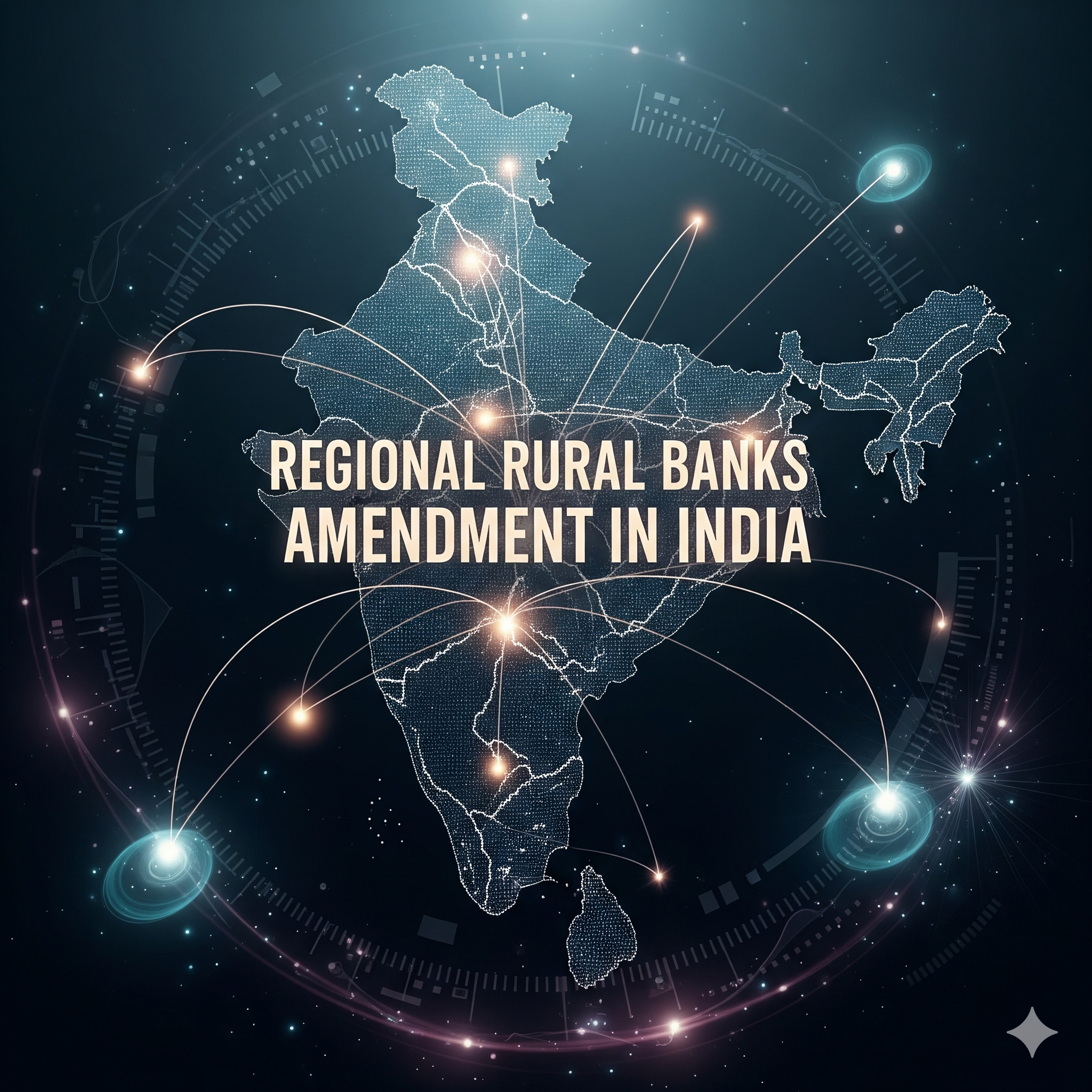Introduction
Regional Rural Banks (RRBs) form an integral part of India’s financial architecture aimed at promoting rural development. Established in 1975 under the Regional Rural Banks Act, 1976, RRBs were designed to combine the local feel and accessibility of cooperatives with the professionalism and financial strength of commercial banks. Over the years, however, RRBs faced challenges related to capital adequacy, limited operational freedom, and governance issues.
To address these bottlenecks, the Government of India introduced the Regional Rural Banks (Amendment) Bill, 2014, which later became the Regional Rural Banks (Amendment) Act, 2015. This amendment significantly reshaped the governance, capital structure, and expansion possibilities of RRBs. Since then, further reforms have also been initiated to align RRBs with modern banking practices and digital inclusion goals.
This article explores the history, provisions, significance, impact, and future prospects of the RRB Amendment Bill 2015 and subsequent reforms in detail.
Historical Context of RRBs
- Origin of RRBs (1975–1976):
RRBs were established under the recommendations of the Narasimham Committee (1975). The idea was to provide credit and banking facilities to rural farmers, artisans, and small entrepreneurs who were largely excluded from the reach of commercial banks.
The first RRB, Prathama Bank, was set up in 1975 in Uttar Pradesh. - Ownership Structure:
According to the RRBs Act, 1976, their ownership was divided as follows:- 50% – Central Government
- 15% – State Government
- 35% – Sponsor Bank (a public sector commercial bank)
- Challenges before 2015:
- Weak capital base due to restrictions on raising funds from the market.
- Limited geographical expansion opportunities.
- Governance issues as appointments were controlled heavily by the government.
- Growing competition from cooperative banks and microfinance institutions.
It was against this backdrop that the RRB Amendment Bill 2015 was introduced.
The RRB Amendment Bill, 2015 – Key Provisions
The Regional Rural Banks (Amendment) Bill, 2014 was passed by Parliament and became an Act in January 2015. Its major provisions were:
1. Capital Raising Powers
- Prior to the amendment, RRBs could not raise capital from the open market.
- The amendment allowed RRBs to raise capital from sources other than the central government, state government, and sponsor bank.
- However, the shareholding of the Central and State Governments and the Sponsor Bank must remain at least 51% (combined), ensuring majority public ownership.
2. Authorized Capital Increase
- The authorized capital of RRBs was increased from ₹5 crore to ₹2,000 crore, providing more room for growth and expansion.
3. Flexibility in Appointments
- The amendment gave the Central Government greater flexibility in appointing directors to the boards of RRBs.
- It also allowed for professional experts to be appointed, enhancing governance quality.
4. Tenure of Directors
- The tenure of directors was fixed at not more than three years, ensuring rotation and fresh perspectives.
5. Simplification of Procedures
- The amendment empowered the Board of Directors to recommend capital raising decisions.
- This reduced the dependency on central approvals for expansion plans.
Objectives of the RRB Amendment Act, 2015
The main goals of the amendment were:
- Strengthening Financial Stability: By increasing authorized capital and allowing market-based funding.
- Improving Governance: Through flexible board appointments and fixed tenure.
- Enhancing Rural Credit Delivery: By giving RRBs more operational freedom.
- Enabling Expansion: By reducing constraints on capital mobilization and branch expansion.
- Modernizing RRBs: To bring them at par with commercial banks in terms of efficiency and competitiveness.
Impact of the RRB Amendment Act, 2015
1. Capital Mobilization
- RRBs could now raise funds through public issues, private placements, and institutional investors.
- This improved their financial capacity to serve farmers, small businesses, and rural households.
2. Governance Reforms
- With new appointment rules, RRB boards became more professional.
- Inclusion of experts helped in strategic planning, digital adoption, and risk management.
3. Credit Expansion to Farmers
- Post-amendment, RRBs were able to lend more effectively under schemes such as Kisan Credit Card (KCC) and Pradhan Mantri Fasal Bima Yojana (PMFBY).
- Agricultural loans and microloans witnessed steady growth.
4. Technological Upgradation
- Many RRBs adopted Core Banking Solutions (CBS), mobile banking, and digital payment systems.
- They started offering Direct Benefit Transfer (DBT) services for schemes like PM-Kisan.
5. Mergers and Consolidation
- Following the amendment, several RRBs were merged to enhance efficiency and reduce costs.
- Example: In Uttar Pradesh, Allahabad UP Gramin Bank and Lucknow Kshetriya Gramin Bank were merged.
Further Developments After 2015
1. RRB Recapitalization (2017 onwards)
- The government, in collaboration with NABARD, infused capital into weak RRBs.
- This ensured compliance with Basel-III norms and strengthened balance sheets.
2. Digital Push
- RRBs were brought under digital inclusion programs, such as Aadhaar-enabled payment systems, mobile apps, and Rupay debit cards.
- This aligned rural banking with the Digital India campaign.
3. RRB Merger Drive (2018–2021)
- The number of RRBs was reduced through consolidation for better efficiency.
- By 2022, the total number of RRBs had come down to around 43 from the earlier 196.
4. RRB Reforms Roadmap 2021
- NABARD and the government prepared a roadmap for making RRBs profitable by 2025.
- Emphasis was placed on technology, customer service, and rural entrepreneurship finance.
5. RRB and Farmer Economy
- RRBs played a vital role in implementing schemes like PM-Kisan, Atmanirbhar Bharat Abhiyan, and Jan Dhan Yojana.
- They became the backbone of rural credit delivery, especially for small and marginal farmers.
Future of RRBs in India
The future role of RRBs is crucial in shaping rural India’s financial landscape. Key aspects include:
- Financial Inclusion Driver – RRBs are expected to remain at the forefront of rural financial inclusion.
- Digital Transformation – Increased use of AI, blockchain, and mobile banking in rural finance.
- Support to Agri-Tech and Startups – RRBs may extend credit to rural startups, agri-tech ventures, and self-help groups.
- Green and Sustainable Finance – Future RRB lending may align with renewable energy and sustainable agriculture projects.
- Global Linkages – With strengthened capital structures, RRBs may collaborate with international agencies for rural development funding.
Challenges Ahead
Despite reforms, RRBs continue to face challenges:
- Non-Performing Assets (NPAs): High defaults in agricultural loans.
- Limited Autonomy: Still dependent on government for key decisions.
- Infrastructure Gaps: Many rural branches lack proper connectivity and trained staff.
- Competition: Growing competition from NBFCs, fintechs, and microfinance institutions.
Conclusion
The Regional Rural Banks (Amendment) Act, 2015 was a landmark reform in India’s rural financial sector. By increasing authorized capital, allowing market fundraising, and improving governance, it empowered RRBs to expand their outreach and efficiency. Subsequent reforms, including consolidation, digital adoption, and recapitalization, further strengthened their role.
Today, RRBs stand as a bridge between government policies and rural households, ensuring that the benefits of India’s economic growth reach the grassroots. Going forward, RRBs must continue adapting to digital trends, sustainable finance, and inclusive growth models to remain relevant and impactful.




